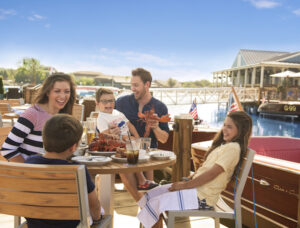Maximize your Family Travel Times to make your Adventures Memorable
If you’ve ever embarked on a family vacation, you know that those moments of exploration, laughter, and bonding are priceless. Family travel times are where memories are made, stories are woven, and adventures become part of your family’s lore. Whether you’re planning a road trip, boarding a plane, or even considering a cruise, this ultimate guide is your ticket to opening the full potential of your family’s travel experiences.
In this guide, we won’t just talk about packing lists and itineraries – we’re going to dive deep into the heart of family travel times, sharing tips, tricks, and stories that will make your adventures unforgettable. So, buckle up, grab your passports, and let’s embark on a journey where we’ll discover the world while strengthening the bonds of your family.
The Art of Family Travel
Before we discuss the practical tips and destination ideas, let’s take a moment to appreciate the art of family travel. It’s not just about ticking off places on your bucket list; it’s about savoring each moment and creating cherished memories that will last a lifetime.
A Family Affair: Family travel times are more than just vacations; they’re collective experiences that bring you closer to your loved ones. It’s a time when siblings become best friends, and parents turn into heroes as they navigate unfamiliar territories together.
Creating Traditions: Every family has their unique travel traditions, from the classic “I Spy” game during road trips to the first ice cream stop in a new city. These traditions become part of your family’s story, passed down from one generation to the next.
The Unexpected: One thing about travel is that it’s full of surprises. From stumbling upon untold stories in a foreign city to sharing stories with fellow travelers, the unexpected moments often become the highlights of your journey.
Education Beyond the Classroom: Travel is a great teacher. It exposes children to different cultures, cuisines, languages, and histories. It’s a hands-on education that leaves a lasting impact.
Bonds That Last: The adventures you share during family travel times create bonds that withstand the test of time. When you look back, it’s not just the destinations you remember; it’s the laughter, the mishaps, and the shared joy.
Packing Essentials for Family Travel Times
Packing—the ultimate pre-trip puzzle. When you’re gearing up for your family adventure, it’s easy to feel like you’re trying to fit a square peg into a round hole. But fear not, because we’ve got your back with some savvy packing essentials that will turn you into a packing pro.
Packing Smart: What You Can’t Forget
You might have just touched down at a new destination, and you open your suitcase only to realize you forgot your phone charger. To avoid such travel blunders, create a checklist of must-haves:
- Travel Documents: Passports, visas, IDs, and any necessary reservations. Keep them close, and make copies as backups.
- Medication: If anyone in your family takes prescription meds, ensure you have an ample supply for the trip.
- Clothing Basics: Think underwear, socks, and weather-appropriate attire. It’s easy to get caught up in fashion, but sometimes, it’s the basics that matter most.
- Toiletries: Toothbrushes, toothpaste, and other personal care items. Don’t forget the sunscreen and bug spray, depending on your destination.
- Entertainment: Whether it’s a favorite book, a deck of cards, or a tablet for movies, having entertainment on hand can be a lifesaver during downtime.
- Snacks: Hungry travelers are grumpy travelers. Pack some snacks for the journey, especially if you have picky eaters in tow.
- Travel Adapters: Different countries, different plugs. Make sure your electronic devices can stay charged.
- First Aid Kit: Band-Aids, antiseptic wipes, and any special medical supplies you might need.
- Reusable Water Bottles: Staying hydrated on the go is crucial. Plus, it’s eco-friendly!
Space-Saving Tips for Packing Efficiently
Now that you’ve got your essentials, it’s time to pack them efficiently. Here are some tricks to maximize your suitcase space:
- Roll, Don’t Fold: Roll your clothes instead of folding them. This saves space and minimizes wrinkles.
- Use Packing Cubes: These nifty organizers keep your belongings neat and separated.
- Double-Duty Clothing: Choose versatile pieces that can be mixed and matched to create different outfits.
- Vacuum-Seal Bags: These can be a game-changer for bulky items like winter coats or extra blankets.
- Travel-Sized Toiletries: Buy travel-sized versions of your favorite toiletries or use refillable bottles.
Traveling Light: Minimalist Packing Strategies
If you’re feeling adventurous, consider taking up a minimal packing. It’s about packing only what you truly need, and it has its perks:
- Less Stress: Fewer items mean less to worry about. You’ll spend less time packing and unpacking.
- Easier Mobility: Traveling light makes it easier to navigate airports, train stations, and hotels.
- Room for Souvenirs: You’ll have extra space for souvenirs and goodies you pick up along the way.
- No Baggage Fees: Most airlines charge for checked bags. Traveling light can save you money.
Remember, it’s not about how many outfits you can bring; it’s about the experiences you’ll have. So, pack smart, pack light, and get ready to embark on your family travel adventure with confidence. In the next section, we’ll delve into budget-friendly family travel tips to help you make the most of your journey without breaking the bank.
Budget-Friendly Family Travel Times: How to Save Big
Traveling with the family doesn’t have to break the bank. In fact, with a little know-how and some smart strategies, you can have an amazing adventure without emptying your wallet. Let’s dive into the world of budget-friendly family travel times and discover how to save big while having a blast.
Family Travel on a Shoestring Budget
The Shoestring Philosophy: Having a shoestring budget doesn’t mean sacrificing fun. It means being savvy and finding creative ways to stretch your dollars.
Off-Peak Travel: Consider traveling during off-peak seasons. You’ll find lower prices, fewer crowds, and a more relaxed atmosphere.
Accommodation Options: Explore a variety of accommodations, from budget-friendly hotels and hostels to vacation rentals and camping. Each has its unique charm and cost-saving benefits.
Public Transportation: In many cities, public transportation is not only budget-friendly but also a great way to experience local life. Skip the rental car and hop on a bus or subway.
Finding Deals and Discounts for Families
Advance Booking: Plan and book your accommodations and flights well in advance. Early birds often get the best deals.
Travel Apps and Websites: Use travel apps and websites to find discounts on flights, hotels, and activities. Keep an eye on flash sales and last-minute deals.
Family Memberships: Look into memberships or passes for attractions, museums, and theme parks. They can often save you a bundle, especially if you plan to visit multiple places.
Loyalty Programs: Join loyalty programs with airlines and hotel chains. Accumulate points for future discounts and perks.
Money-Saving Strategies for Dining and Activities
Picnic Adventures: Instead of dining out for every meal, consider picnicking in local parks or enjoying a meal on the go. It’s not only cost-effective but also a great way to savor local flavors.
Free and Low-Cost Attractions: Research free or low-cost attractions and activities at your destination. Many cities offer free walking tours, museums, and cultural events.
Cook Your Meals: If you have access to a kitchen in your accommodation, take advantage of it. Cooking some of your meals can save a significant amount of money.
BYOB (Bring Your Bottle): Carry reusable water bottles and refill them throughout the day to avoid pricey bottled water.
Haggle Wisely: In some places, haggling is a cultural norm. Don’t be afraid to negotiate prices at markets and street vendors but do it respectfully.
Remember, budget-friendly family travel times are not about skimping on experiences but about making smart choices that allow you to enjoy your journey to the fullest without worrying about your wallet. Next up, we’ll dive into the nitty-gritty of planning your family travel times, so you can create a seamless itinerary that caters to everyone’s interests.
Planning Your Family Travel Times: Step-by-Step Guide
Planning a family trip can be both exciting and overwhelming. To make the process smoother and more enjoyable, let’s walk through a step-by-step guide to crafting the perfect family travel experience. From creating the ideal itinerary to booking accommodations and handling travel documents, we’ve got you covered.
Crafting the Perfect Family Travel Itinerary
Know Your Family’s Interests: Start by understanding what each family member enjoys. Whether it’s history, adventure, or relaxation, tailor your itinerary to accommodate everyone’s preferences.
Balance Activities: Mix up your daily activities. Blend sightseeing with leisure time, ensuring that there’s something for every member of the family.
Flexibility Is Key: While having a plan is crucial, leave room for spontaneity. Some of the best moments happen when you’re open to unexpected adventures.
Booking Accommodations: Tips and Tricks

Family-Friendly Accommodations: Look for accommodations specifically designed for families. These places often provide kid-friendly amenities and activities.
Read Reviews: Don’t underestimate the power of online reviews. They can give you insights into the experiences of other families and help you make informed decisions.
Consider Vacation Rentals: Vacation rentals can be cost-effective and offer a more home-like environment, which is often appreciated by families, especially those with young children.
Navigating Travel Documents and Visas

Check Passport Validity: Ensure that all family members’ passports are valid for at least six months beyond your planned return date. Some countries have this requirement for entry.
Visa Requirements: Research the visa requirements of your destination country. Some places allow visa-free entry for a specific duration, while others require advance visa applications.
Travel Insurance: Consider purchasing travel insurance that covers unexpected events, such as trip cancellations or medical emergencies. It provides peace of mind during your travels.
By following these steps and incorporating the interests and preferences of your family members, you can create a well-rounded itinerary and ensure a smooth travel experience. In the next section, we’ll delve into the importance of ensuring safety during your family travel times, offering practical tips and guidelines to keep everyone secure and happy.
Family Travel Times with Kids: Tips for a Smooth Journey
Traveling with kids can be an adventure in itself, and with the right approach, it can be a smooth and enjoyable one. In this section, we’ll share some valuable tips to ensure your family travel times with kids are memorable for all the right reasons.
Keeping Kids Entertained During Travel

The Entertainment Arsenal: Pack an arsenal of entertainment options. Tablets, e-readers, coloring books, and travel-sized board games can be lifesavers during long journeys.
Snack Attack: Keep a variety of snacks on hand. Hungry kids can turn into grumpy travel companions. Healthy and easy-to-eat snacks can save the day.
Interactive Maps: Get kids involved in the journey by using interactive maps or travel apps that let them track your progress and learn about the places you’re visiting.
Audio Stories: Consider audiobooks or storytelling podcasts. They’re not only entertaining but also educational.
Managing Meltdowns and Jet Lag

Sleep Schedule Adjustments: Gradually adjust your kids’ sleep schedules to match your destination’s time zone a few days before your trip. This can help reduce the impact of jet lag.
Familiar Comforts: Bring along comfort items like a favorite stuffed animal or blanket. Familiar objects can provide a sense of security in unfamiliar places.
Patience Is Key: Be patient with meltdowns. Traveling can be overwhelming for little ones. A bit of understanding and comfort can go a long way in calming them down.
Plan for Rest: Don’t over-schedule your days. Leave room for breaks and naps, especially if you have young children. A well-rested child is a happier traveler.
Traveling Safely with Infants and Toddlers

Baby girl sleeping on mother’s laps while traveling in airplane.
Car Seat Safety: If you’re renting a car, ensure it’s equipped with the appropriate car seats for your kids. Safety should always be a top priority.
Babyproofing: If you’re staying in accommodations, ask if they offer babyproofing options or bring your childproofing gear to ensure a safe environment.
Medication and First Aid: Carry any necessary medications and a basic first aid kit. It’s better to be prepared for minor injuries or illnesses.
Stay Together: In crowded places or busy tourist spots, use child leashes or harnesses for toddlers to prevent them from wandering off.
Traveling with kids may have its challenges, but it also offers incredible rewards. These tips can help you navigate those challenges while ensuring your family travel times with kids are filled with joy and cherished memories. In the next section, we’ll explore accommodation options that cater specifically to families, offering a comfortable and enjoyable stay for all.
Best Accommodation Options for Family Travel Times
Selecting the right accommodation can significantly impact the overall experience of your family travel times. From family-friendly hotels and resorts to the growing trend of vacation rentals and unique camping or glamping adventures, we’ll guide you through your options to help you make the best choice for your family.
Family-Friendly Hotels and Resorts

Family having fun on summer vacations.
Kid-Friendly Amenities: Many hotels and resorts offer family-friendly amenities such as children’s pools, game rooms, and on-site activities for kids. Look for accommodations that cater to families.
Convenience: Staying at a hotel or resort often means you have access to concierge services, on-site dining options, and room service, which can make your stay more convenient.
Social Opportunities: Resorts often host family-oriented events and activities, providing opportunities for your kids to make new friends while you enjoy some relaxation time.
Vacation Rentals vs. Hotels: Pros and Cons
Vacation Rentals
Pros:
- Space: Vacation rentals typically offer more space than hotel rooms, providing separate bedrooms, living areas, and kitchens.
- Privacy: Enjoy the privacy of a home away from home.
- Local Experience: Live like a local, experiencing your destination from a different perspective.
Cons:
- Less Services: You won’t have daily housekeeping or concierge services like in hotels.
- Limited Amenities: Vacation rentals may not have the same amenities as resorts, such as on-site restaurants or pools.
Hotels
Pros:
- Services: Access to services like room cleaning, concierge, and on-site dining.
- Amenities: Hotels often have pools, fitness centers, and other on-site facilities.
- Consistency: Hotels offer a consistent experience wherever you go.
Cons:
- Space: Hotel rooms can be smaller and less family-friendly than vacation rentals.
- Less Local Experience: You might not immerse yourself in the local culture as much as in a vacation rental.
Camping and Glamping: Unique Stay Options

two dark-skinned boys with an afro hairstyle and their young Asian mother sit in a glamping dome and look out the transparent window
Camping
Pros:
- Nature Immersion: Camping allows you to connect with nature and enjoy the great outdoors.
- Cost-Efficient: Camping can be one of the most budget-friendly accommodation options.
Cons:
- Basic Amenities: You’ll have fewer amenities and comforts compared to hotels or vacation rentals.
- Preparation: Camping requires more preparation and equipment.
Glamping (Glamorous Camping)
Pros:
- Luxury Comforts: Glamping offers the experience of camping with added comforts like comfortable beds and private bathrooms.
- Scenic Locations: Many glamping sites are located in picturesque natural settings.
Cons:
- Higher Cost: Glamping tends to be more expensive than traditional camping.
- Availability: Glamping options may be limited to certain destinations.
When choosing your accommodation, consider your family’s preferences, budget, and the type of experience you want to create. Each option offers a unique way to enjoy family travel times, so make the choice that suits your family’s needs and desires. In the next section, we’ll explore how to create engaging and diverse itineraries that cater to every member of your family, ensuring a fulfilling travel experience.
Family Travel Times: Creating Itineraries for All Ages
One of the joys of family travel times is the opportunity to bond, explore, and make lasting memories together. To make the most of your journey, it’s essential to tailor your itinerary to suit the interests and needs of every family member, regardless of age.
Tailoring Activities to Different Age Groups
Young Explorers (Ages 0-5)
- Interactive Museums: Look for children’s museums or science centers where little ones can engage their curious minds.
- Animal Encounters: Zoos, aquariums, and petting farms are perfect for introducing young children to wildlife.
Adventurous Kids (Ages 6-12)
- Outdoor Adventures: Plan hikes, bike rides, or nature walks suitable for their energy levels.
- Cultural Experiences: Visit historical sites with engaging stories that captivate young minds.
Teens and Tweens (Ages 13-17)
- Adventure Activities: Teens often enjoy more adventurous pursuits like zip-lining, kayaking, or even scuba diving.
- Independent Explorations: Give them some freedom to explore on their own or with friends in safe areas.
Family Adventures for Teens and Tweens
Engaging Activities: Involve your older kids in the planning process. Let them choose activities or attractions that interest them to keep them engaged and excited.
Learning Opportunities: Seek educational experiences that align with their interests, whether it’s history, science, art, or culture.
Adventure-Driven Destinations: Consider destinations known for adventure sports or outdoor activities, as these can be a hit with teenagers.
Enjoying Adult Time on Family Trips
While family bonding is crucial, it’s also essential to carve out some adult time for relaxation and connection.
Kids’ Clubs: Many resorts offer supervised kids’ clubs where children can enjoy age-appropriate activities while parents have some quality alone time.
Date Nights: Plan a date night. Some resorts offer babysitting services, allowing parents to enjoy a romantic dinner or evening entertainment.
Teens’ Independence: If you have teenagers, allow them some independence to explore on their own, giving you and your partner some time alone.
Creating a well-rounded itinerary that caters to different age groups ensures that everyone in the family can enjoy the journey to the fullest. In the next section, we’ll emphasize the importance of safety during family travel times and provide valuable tips to keep your loved ones secure while exploring new destinations.
Read – Travel Advice from a Foodie
Safety First: Preparing for Family Travel Times
When it comes to family travel, safety should always be a top priority. Whether you’re exploring a new city, hiking in the wilderness, or lounging on a beach, being prepared and informed can make all the difference in ensuring a safe and enjoyable journey.
Essential Safety Precautions for Family Travel

Stay Informed: Research your destination in advance. Understand the local customs, laws, and potential risks. Stay updated on current events in the area.
Emergency Contacts: Carry a list of emergency contacts, including local authorities, your country’s embassy or consulate, and contact information for your accommodations.
Travel with Essentials: Pack a basic first aid kit with items like band-aids, antiseptic wipes, pain relievers, and any necessary prescription medications.
Stay Hydrated: Ensure everyone drinks enough water, especially in hot climates. Dehydration can be a common issue during travel.
Emergency Plans and Health Considerations
Emergency Meeting Points: Establish meeting points and protocols for what to do if family members get separated. Ensure everyone knows how to contact each other.
Health Precautions: Research any required vaccinations or health precautions for your destination. Consult your healthcare provider well in advance of your trip.
Travel Health Insurance: Consider purchasing travel health insurance. It can provide coverage for medical emergencies, trip cancellations, and other unexpected events.
Travel Insurance: Is It Worth It?
Medical Emergencies: Travel insurance can cover medical expenses in case of illness or injury, which can be especially important when traveling with children.
Trip Cancellation: If unforeseen circumstances force you to cancel or interrupt your trip, travel insurance can help you recover non-refundable expenses.
Lost Luggage: It can also provide compensation for lost, stolen, or delayed luggage.
Peace of Mind: While it comes at a cost, travel insurance provides peace of mind, knowing that you’re financially protected in case of unexpected events.
Before purchasing travel insurance, carefully review the policy to understand what it covers and any exclusions. It’s essential to choose a plan that aligns with your family’s specific needs and travel style.
By prioritizing safety, staying informed, and being prepared, you can minimize potential risks and focus on making wonderful memories during your family travel times. In the next section, we’ll delve into the exciting aspect of immersing your family in the local culture and traditions of your destination, creating a rich and memorable travel experience.
Cultural Immersion on Your Family Travel Times
One of the most rewarding aspects of family travel times is the opportunity to immerse yourselves in the local culture and traditions of your destination. This cultural immersion not only enriches your travel experience but also teaches your family valuable lessons about the world and its diversity.
Experiencing Local Culture and Traditions
Local Cuisine: Explore the local food scene. Try traditional dishes, visit markets, and engage with locals to discover the flavors of your destination.
Festivals and Events: Check if any festivals or cultural events are happening during your visit. These can provide unique insights into the local culture.
Art and History: Visit museums, galleries, and historical sites to learn about the area’s art, history, and heritage.
Traditional Activities: Participate in traditional activities such as dance, music, or crafts workshops. These hands-on experiences create lasting memories.
Language Barriers and How to Overcome Them
Learn Basic Phrases: Before your trip, learn a few basic phrases in the local language. Locals often appreciate when visitors make an effort to communicate in their language.
Translation Apps: Use translation apps to help bridge language barriers. Many apps can translate spoken language or text in real time.
Local Guides: Hire local guides who can provide insights, translate, and enhance your understanding of the culture.
Nonverbal Communication: Sometimes, gestures and body language can help convey your message when words fail.
Volunteering and Giving Back While Traveling
Volunteer Opportunities: Research opportunities to volunteer as a family. This can be a meaningful way to give back to the local community.
Responsible Tourism: Choose tour operators and accommodations that prioritize responsible and sustainable tourism practices. Your choices can have a positive impact on the environment and local communities.
Support Local Businesses: Buy souvenirs and goods from local artisans and businesses. Your purchases can directly contribute to the local economy.
Cultural Respect: Show respect for local customs and traditions. Dress modestly when required, ask for permission before taking photos, and follow any cultural norms.
Cultural immersion not only fosters a deeper understanding of the world but also promotes empathy, tolerance, and appreciation for diversity. It’s an invaluable aspect of family travel that can leave a lasting impact on your family’s perspective and values.
Foodie Adventures: Dining with Kids on Family Travel Times
Exploring local cuisine is an integral part of any travel experience, and when you’re traveling with kids, it can also be a fun and educational adventure. Here, we’ll dive into the world of foodie adventures and share tips on dining with kids, even if you have picky eaters in the family.
Exploring Local Cuisine with Picky Eaters

Start Slow: Introduce new flavors gradually. Begin with familiar dishes that have a local twist, and then gradually move on to more adventurous options.
Food Exploration: Turn dining into a culinary exploration. Encourage your kids to ask questions about the food, its ingredients, and its cultural significance.
Local Markets: Visit local markets and food stalls. Let your kids pick out some snacks or fruits they’d like to try. It’s a hands-on way to engage them in the food experience.
Food Diaries: Encourage your children to keep a food diary or journal, where they can jot down their thoughts and feelings about the different dishes they try.
Family-Friendly Restaurants and Street Food

Research Kid-Friendly Restaurants: Look for restaurants that are known for being family-friendly. They often have kid’s menus, high chairs, and play areas.
Street Food Adventures: Street food can be a delightful experience for kids. Explore food markets or street vendors offering local delicacies.
Picnics: Consider having a picnic with local goodies in a park or by the beach. It’s a relaxed way to enjoy a meal while taking in the scenery.
Cooking at Accommodation: If you’re staying in accommodations with kitchen facilities, involve your kids in preparing a meal using local ingredients.
Cooking Classes and Food Tours for Families

Cooking Classes: Many destinations offer family-friendly cooking classes. It’s a fantastic way to learn about local cuisine and engage your children in the culinary arts.
Food Tours: Join food tours designed for families. They often include tastings and cultural insights, making it an educational and delicious experience.
Local Hosts: Connect with locals who offer dining experiences in their homes. It’s an authentic way to share a meal and learn about local life.
Cultural Etiquette: Teach your children about cultural etiquette when dining. It’s an opportunity to learn about respecting local customs and traditions.
Foodie adventures not only tantalize your taste buds but also provide a unique window into the culture and traditions of your destination. Embracing local cuisine with your family can create lasting memories and foster an appreciation for diverse flavors. In the next section, we’ll explore the art of capturing your family travel times through photography and storytelling, allowing you to relive your adventures for years to come.
Read – Travel Advice from a Foodie
Photography Tips for Capturing Family Travel Times Memories
Photography is a wonderful way to preserve the memories of your family travel times. With some simple tips and tricks, you can capture precious moments, create stunning travel photo albums, and ensure that your adventures are preserved for generations to come.
Capturing Precious Moments: Photography Essentials
Know Your Camera: Whether you’re using a smartphone, a compact camera, or a DSLR, familiarize yourself with its features and settings. Practice before your trip to feel more confident.
Natural Light: Whenever possible, use natural light. Early morning and late afternoon often offer the best lighting conditions for outdoor shots.
Candid Shots: Capture candid moments. Sometimes, the most authentic and heartwarming photos happen when your family is unaware of the camera.
Composition: Pay attention to composition. Use the rule of thirds, leading lines, and framing to create visually appealing shots.
Focus on Details: Don’t forget the small details—the textures, colors, and unique features of your destination can make for captivating photos.
Creating Stunning Travel Photo Albums

Organize Your Photos: Sort your photos by date or location to make it easier to create a chronological or thematic album.
Tell a Story: Your photo album should tell a story. Include images of your family exploring, experiencing local culture, and enjoying moments together.
Mix It Up: Incorporate a variety of photo styles, from landscapes and portraits to close-ups and action shots. It adds depth to your album.
Add Captions: Include captions to provide context and share the stories behind the photos. It helps future generations connect with your memories.
Digital Albums: Consider creating a digital photo album that can be easily shared with friends and family. Many online platforms make this process straightforward.
Preserving Memories for Generations
Backup Your Photos: Ensure that your photos are backed up in multiple locations. Use cloud storage or external hard drives to protect against data loss.
Printed Albums: Create physical photo albums. There’s something special about flipping through tangible pages of memories.
Share Stories: When sharing your travel photos, also share stories. Explain the significance of each moment and the emotions you felt.
Pass It On: Encourage your children to get involved in preserving memories. Let them take their photos and create their albums.
Reflect and Revisit: Periodically revisit your travel photos as a family. It’s a wonderful way to relive your adventures and spark conversations about past trips.
Photography is a powerful tool for capturing the essence of your family’s travel times. By applying these photography tips and creating thoughtful photo albums, you’ll ensure that your travel memories are cherished for generations to come.
Road Trips: A Classic Approach to Family Travel Times
Embarking on a road trip with your family is a classic and unforgettable way to explore new places and create lasting memories. In this section, we’ll guide you through the essentials of planning epic family road trips, ensuring safety and entertainment on the journey, and discovering some iconic road trip routes perfect for families.
Planning Epic Family Road Trips
Choose the Right Route: Research and select a route that offers a mix of attractions and activities suitable for all family members. Consider scenic routes, national parks, and family-friendly destinations.
Itinerary Flexibility: Keep your itinerary flexible. Leave room for spontaneous detours and extra stops to explore unexpected treasures along the way.
Accommodation Reservations: If you plan to stay in hotels or motels, consider making reservations in advance, especially during peak travel seasons. For camping, check campsite availability.
Packing Essentials: Pack essentials such as first aid supplies, roadside emergency tools, maps, and a GPS device or navigation app. Ensure your vehicle is in good working condition.
Car Safety and Entertainment Tips
Safety First: Ensure everyone is properly buckled up at all times. Double-check car seats and booster seats to ensure they’re securely installed.
Entertainment for All Ages: Bring a variety of entertainment options for kids of different ages, such as books, games, and movies. Consider a portable DVD player or tablet.
Roadside Breaks: Plan regular breaks for stretching, bathroom stops, and snacks. It’s an opportunity to explore interesting places along the way.
Healthy Snacks: Pack a cooler with healthy snacks and drinks to avoid too many fast food stops. Include a mix of fruits, veggies, and protein-rich options.
Iconic Road Trip Routes for Families
Pacific Coast Highway, California: Take a scenic drive along California’s coast, exploring rugged cliffs, picturesque beaches, and charming coastal towns.
Blue Ridge Parkway, Virginia and North Carolina: Wind through the stunning Appalachian Mountains, with opportunities for hiking, picnicking, and enjoying breathtaking views.
Route 66, USA: Travel the historic Route 66, known as the “Main Street of America,” with quirky roadside attractions and a taste of American nostalgia.
Great Ocean Road, Australia: Discover Australia’s stunning coastline, including the famous Twelve Apostles rock formations.
Ring Road, Iceland: Explore Iceland’s natural wonders, from waterfalls and glaciers to geothermal hot springs, on the Ring Road.
Family road trips offer the freedom to create your adventure, explore at your own pace, and bond with your loved ones while discovering new places. By following these tips and considering iconic road trip routes, you can embark on an unforgettable journey filled with family travel times you’ll treasure forever.
Solo Parenting on Family Travel Times: Survival Guide
Traveling as a solo parent with your children can be a rewarding and enriching experience, but it also comes with unique challenges. In this section, we’ll provide you with a survival guide, offering tips, inspiration, and advice to make your solo parent travel adventures enjoyable and memorable.
Single Parent Travel: Tips and Inspiration
Plan Ahead: Careful planning is crucial when traveling solo with kids. Create a detailed itinerary, make reservations in advance, and research family-friendly accommodations and activities.
Pack Light: Traveling with kids often means a lot of luggage. Pack efficiently, bring only the essentials, and consider packing cubes or organizers to stay organized.
Travel Insurance: Invest in comprehensive travel insurance that covers medical emergencies and trip cancellations. It provides peace of mind during your journey.
Travel Documents: Ensure that you have all the necessary travel documents for both yourself and your children, including passports, visas, and any required permissions or consent forms.
Connecting with Other Solo Parent Travelers
Online Communities: Join online forums and communities for solo parent travelers. These platforms are great for sharing experiences, seeking advice, and connecting with like-minded parents.
Local Groups: Look for local family travel groups or meetups at your destination. Meeting other families can provide support and companionship during your trip.
Stay in Social Accommodations: Choose accommodations like hostels, guesthouses, or family-friendly resorts with communal spaces where you can meet other travelers.
Solo Parent Tours: Consider joining solo parent group tours or organized trips designed specifically for single parents and their children.
Ensuring a Positive Experience for Kids
Kids’ Involvement: Involve your children in trip planning. Let them choose activities or destinations they’re excited about, and assign them age-appropriate responsibilities during the trip.
Comfort Items: Bring along comfort items like a favorite stuffed animal, blanket, or toy to provide a sense of security, especially in unfamiliar environments.
Safety First: Prioritize safety at all times. Teach your children basic safety rules, such as not talking to strangers and staying together in crowded places.
Positive Attitude: Maintain a positive attitude, even in challenging situations. Your children will often take cues from your demeanor.
Traveling as a solo parent can be a rewarding adventure that strengthens the bond between you and your children while creating lifelong memories. By following these tips, staying connected with other solo parent travelers, and prioritizing your children’s needs, you can ensure a positive and enjoyable family travel experience.
Family Travel Times: Exploring Nature and Outdoor Activities
For families who love the great outdoors, embarking on nature-centric adventures is the perfect way to bond, learn, and create lasting memories together. In this section, we’ll explore the joys of connecting with nature on family adventures, including hiking, camping, and wildlife encounters.
Connecting with Nature on Family Adventures
Nature Walks: Start with gentle nature walks in local parks or nature reserves. Explore trails that are suitable for all family members, including young children.
Nature Journals: Encourage your kids to keep nature journals. They can draw or write about the plants, animals, and landscapes they encounter during their journeys.
Stargazing: Spend evenings stargazing. Teach your children about constellations and the wonders of the night sky.
Botanical Gardens: Visit botanical gardens or arboretums. These places offer a diverse range of plants and often have educational programs for kids.
Hiking, Camping, and Outdoor Fun
Family Hikes: Gradually introduce your children to hiking. Start with short, easy trails and work your way up to more challenging hikes as they gain confidence.
Camping Adventures: Camping can be an exciting family adventure. Choose campgrounds with amenities like restrooms and easy access to nature.
Outdoor Games: Bring along outdoor games such as frisbees, kites, or soccer balls to keep the kids active and entertained.
Nature Scavenger Hunts: Create nature scavenger hunts with lists of things for your kids to find, such as different types of leaves, rocks, or animal tracks.
Wildlife Encounters and Nature Reserves
Wildlife Safaris: If you have the opportunity, go on wildlife safaris or guided nature tours. It’s an excellent way for your kids to observe animals in their natural habitats.
Zoos and Aquariums: Visit local zoos and aquariums to learn about animals from around the world. Many facilities offer educational programs and interactive exhibits.
Nature Reserves: Explore nature reserves and protected areas. These places are often dedicated to preserving the natural environment and provide opportunities for birdwatching and wildlife viewing.
Respect Wildlife: Teach your children about respecting wildlife and their habitats. Observe animals from a safe distance and avoid disturbing them.
Connecting with nature through outdoor activities not only promotes physical health but also fosters a deep appreciation for the environment and the importance of conservation. Whether you’re hiking through scenic landscapes, camping under the stars, or observing wildlife in their natural habitats, these family adventures in nature will create treasured moments that your family will cherish for years to come.
Traveling with Pets on Your Family Travel Times
For many families, pets are cherished members of the household, and including them in your family travel times can add an extra layer of joy to your adventures. In this section, we’ll explore pet-friendly travel tips, destinations, and how to prepare your pet for travel.
Pet-Friendly Travel Tips and Destinations
Research Pet Policies: Before planning your trip, research the pet policies of airlines, accommodations, and attractions. Ensure they are pet-friendly and have the necessary facilities.
Pet Training: Invest time in training your pet to ensure they are well-behaved during travel. Basic commands like “sit,” “stay,” and “quiet” can be incredibly useful.
Travel-Friendly Gear: Purchase travel-friendly gear for your pet, including a secure carrier or harness, food and water bowls, bedding, and toys.
Health Check: Schedule a visit to the veterinarian before your trip. Ensure your pet is up-to-date on vaccinations and has a clean bill of health for travel.
Pet Identification: Ensure your pet has proper identification, including a collar with an ID tag that displays your contact information. Consider microchipping as an added safety measure.
Car Safety: If you’re traveling by car, use a pet seat belt or a secure carrier to keep your pet safe during the journey.
Plan Breaks: Schedule frequent breaks during long car trips to allow your pet to stretch their legs, relieve themselves, and stay comfortable.
Pet-Friendly Destinations: Choose destinations and activities that are suitable for pets. Look for pet-friendly parks, hiking trails, and beaches.
Preparing Your Pet for Travel
Familiarize with Carrier: If your pet will be in a carrier, help them get used to it before the trip. Leave it open in your home with treats and toys inside.
Practice Short Trips: If your pet isn’t accustomed to travel, start with short practice trips to get them used to the experience.
Comfort Items: Bring along comfort items from home, such as their favorite blanket or toy, to provide a sense of security during travel.
Pet Medications: If your pet requires medications, ensure you have an adequate supply for the duration of your trip.
Routine Maintenance: Stick to your pet’s routine as closely as possible during travel, including feeding, exercise, and bedtime.
Finding Pet-Friendly Accommodations
Pet-Friendly Accommodations: Look for accommodations that explicitly welcome pets. Many hotels, vacation rentals, and campgrounds offer pet-friendly options.
Check Fees and Policies: When booking accommodations, check for any pet-related fees and their specific policies regarding pets.
Pet Amenities: Some pet-friendly accommodations provide amenities like pet beds, food bowls, and even pet-sitting services.
Read Reviews: Read reviews from other travelers who have stayed at pet-friendly accommodations to get insights into their experiences.
Traveling with your pet can be a rewarding experience that strengthens your bond and creates special family travel times. By following these pet-friendly travel tips and choosing destinations and accommodations that cater to pets, you can ensure a safe and enjoyable journey for both your family and your beloved furry friend.
Cruising with Kids: A Unique Family Travel Times Experience
Cruising with your family can be a unique and exciting way to explore multiple destinations while enjoying a wide range of onboard amenities and activities. In this section, we’ll delve into the world of family cruising, including cruise planning, family-friendly cruise lines and activities, and tips for making the most of your time at sea.
Setting Sail with the Family: Cruise Planning
Choose the Right Cruise: Research cruise lines and itineraries to find one that caters to families. Look for cruises with well-designed kids’ programs and family-friendly amenities.
Consider Cruise Length: Think about the length of the cruise. Shorter cruises may be more suitable for families with younger children, while longer cruises offer more in-depth exploration.
Cabin Selection: When booking, consider cabin options that accommodate your family size comfortably. Some cruises offer family suites or adjoining rooms.
Travel Insurance: Purchase travel insurance that covers trip cancellations, medical emergencies, and other unexpected events. It provides peace of mind during your cruise.
Family-Friendly Cruise Lines and Activities
Cruise Lines: Research cruise lines known for their family-friendly offerings. Some popular options include Disney Cruise Line, Royal Caribbean, and Carnival Cruise Line.
Kids’ Clubs: Many cruise ships have kids’ clubs with age-appropriate activities and supervised programs, allowing parents some downtime.
Family Activities: Look for onboard family activities such as water parks, mini-golf, rock climbing walls, and movie theaters.
Educational Opportunities: Some cruise lines offer educational programs and workshops for kids, combining fun with learning.
Making Memories Afloat: Cruising Tips for Families
Set Ground Rules: Establish ground rules for your children during the cruise, including safety guidelines and expectations for behavior.
Family Dining: Take advantage of family dining options. Many cruise ships have designated family dining areas or offer flexible dining times.
Excursion Planning: Research shore excursions and activities at each port of call. Choose excursions that are suitable for your family’s interests and energy levels.
Pack Wisely: Pack essentials like swimwear, sunscreen, and medications. Don’t forget travel adapters and power strips to keep everyone’s devices charged.
Stay Informed: Attend onboard orientation sessions to get familiar with the ship’s layout and learn about daily activities and events.
Relaxation Time: Schedule some relaxation time for yourself and your partner. Many cruise ships offer babysitting or kids’ club services in the evenings.
Cruising with kids offers a well-rounded family travel experience, combining adventure, entertainment, and relaxation. By planning, selecting the right cruise, and taking advantage of family-friendly amenities, you can create lasting memories afloat and make the most of your family cruise adventure.
Read – How to Travel without a Plan
CONCLUSION
In conclusion, family travel times offer a wealth of opportunities for adventure, bonding, and creating cherished memories. Whether you’re embarking on a road trip, exploring the great outdoors, cruising to exotic destinations, or simply enjoying quality time together, the key to a successful family journey lies in careful planning, safety awareness, and a spirit of exploration.
We’ve covered various aspects of family travel, from packing essentials and budget-friendly strategies to pet-friendly options and solo parenting survival guides. We’ve also explored the joys of immersing your family in local culture, capturing memories through photography, and connecting with nature.
Remember that every family is unique, and your travel experiences should reflect your interests, needs, and preferences. With the right planning, an open spirit of adventure, and a focus on creating meaningful moments, your family travel times are sure to be filled with unforgettable adventures and a lifetime of shared stories. Happy travels!
FAQs
How many times does the average family travel?
The frequency of family travel varies widely and depends on factors such as budget, work schedules, and personal preferences. On average, many families take one or two vacations per year.
What are the statistics for family travel?
Family travel statistics can fluctuate based on various factors. As of my last update in September 2021, a significant percentage of families in the United States took at least one family vacation per year. For the most current and specific statistics, it’s recommended to refer to travel industry reports or surveys conducted by relevant organizations.
How long should Family travel planning take?
The time required for family travel planning depends on the complexity of the trip. Simple trips may require a few weeks of planning, while elaborate international vacations might need several months. It’s advisable to start planning well in advance, especially for destinations with high demand or during peak travel seasons.
How often should you take a Family adventure travel?
The frequency of family adventure travel depends on your family’s interests and resources. Some families enjoy adventurous activities and may plan such trips once a year or more, while others might prefer less frequent adventure vacations. It’s essential to balance adventure travel with other types of family vacations to cater to diverse interests.
How many times a year does the average family go on vacation?
The number of times a family goes on vacation in a year varies widely. While some families aim for one vacation annually, others might take multiple trips, including short getaways and long vacations during school breaks or holidays.
What are Family Travel activities?
Family travel activities encompass a wide range of experiences tailored for families. These activities can include exploring local attractions, visiting museums and zoos, enjoying outdoor adventures like hiking and biking, engaging in water sports, cultural experiences, theme park visits, wildlife encounters, and participating in educational tours or workshops. Family travel activities are designed to be inclusive and enjoyable for all age groups within the family.





No Comments